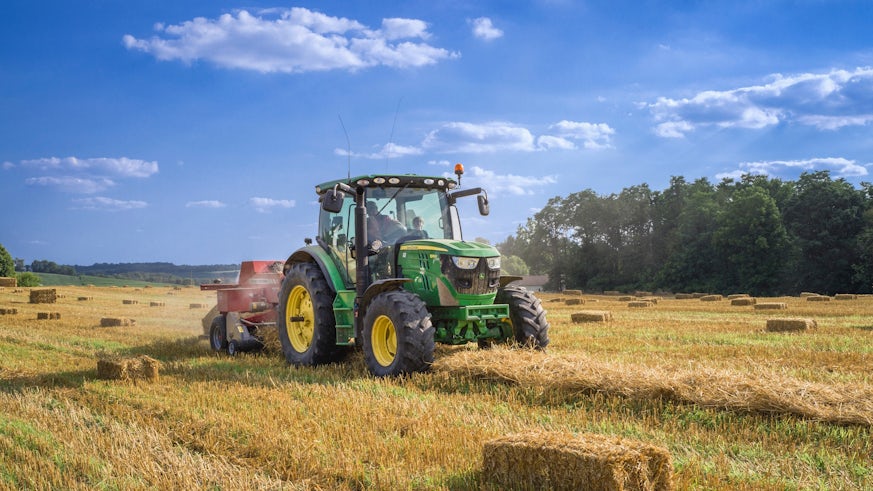Recycling sludge could lead to large plastic pollution reservoirs, study finds
12 January 2023

Agricultural soils across Europe are potentially the biggest global reservoir of microplastics due to the high concentrations found in fertilisers derived from sewage sludge, new research has shown.
Studies have found microplastics – that is, tiny plastic particles measuring between 1mm and 5mm (0.04 in - 0.2 in) in diameter – floating in our drinking water and inside the foods we eat. Research is still inconclusive about how these particles are impacting people and the planet, but experts aren’t optimistic.
Sewage sludge, the byproduct left behind after wastewater is cleaned, is commonly used on agricultural land as a sustainable and renewable source of fertiliser throughout European countries, in part due to EU directives to promote a circular economy. However, this substance has been found to contaminate cropland with often called "forever chemicals", which are commonly found in plastic products and do not break down under normal environmental conditions.
Due to this practice, European farmland could be the biggest global reservoir of microplastics. According to research by Cardiff University and the University of Manchester, between 31,000 and 42,000 tonnes of microplastics, or 86 trillion to 710 trillion microplastic particles, contaminate European farmland each year.
In a study published in the journal Environmental Pollution, the team from the School of Engineering’s Hydro-Environmental Research Centre highlight the magnitude of the environmental problem of microplastic pollution derived from directly recycling sewage sludge into organic fertiliser, suggesting that agricultural soils are likely to be one of the largest environmental reservoirs of microplastic pollution due to the transfer of microplastics from wastewater treatment plants to agricultural land.
The researchers found that up to 650 million microplastic particles entered one wastewater treatment plant in south Wales, in the UK, every day. All these particles ended up in the sewage sludge, rather than being released with the clean water.
The number of microplastics that end up on farmland "is probably an underestimation," says Dr Catherine Wilson, one of the study's co-authors and deputy director of the Hydro-environmental Research Centre at Cardiff University. "Microplastics are everywhere and often so tiny that we can't see them."
The microplastics' concentration on farmland soils in Europe is similar to the amount found in ocean surface waters, says James Lofty, the lead author of the Cardiff study and a PhD research student at the Hydro-environmental Research Centre.
The UK has some of the highest concentrations of microplastics in Europe, with between 500 and 1,000 microplastic particles are spread on farmland there each year, according to Wilson and Lofty's research.
As well as creating a large reservoir of microplastics on land, the practice of using sewage sludge as fertiliser is also exacerbating the plastics crisis in our oceans, adds Lofty. Microplastics spread onto farmland will eventually be transported back into the natural watercourse by means of surface water run-off or infiltration to groundwater. "The major source of plastic contamination in our rivers and oceans is from runoff," he says.
Before they are washed away, however, microplastics can leach toxic chemicals into the soil. Not only are they made from potentially harmful chemicals that can be released into the environment as they break down, microplastics can also absorb other toxic substances, essentially allowing them to transfer to agricultural land where they can leach into the soil, according to Lofty.
While it’s still not totally clear how these particles are affecting human health, high amounts of plastic exposure is probably not good.
Spreading sludge on farmland has been banned in the Netherlands since 1995. The country initially incinerated the sludge, but started exporting it to the UK, where it was used as fertiliser on farmland, after problems at an Amsterdam incineration plant. Switzerland prohibited the use of sewage sludge as fertiliser in 2003 because it "comprises a whole range of harmful substances and pathogenic organisms produced by industry and private households".
The US state Maine also banned the practice in April 2022 after environmental authorities found high levels of Perfluoroalkyl and Polyfluoroalkyl Substances (PFAS) on farmland soil, crops and water. The widespread contamination forced several farms to close.
But a total ban on using sewage sludge as fertiliser is not necessarily the best solution, says Wilson. Instead, it could incentivise farmers to use more synthetic nitrogen fertilisers, made from natural gas, she says.
"With sewage sludge, we're using a waste product in an efficient way, rather than producing endless fossil fuel fertilisers," says Wilson. The organic waste in sludge also helps return carbon to the soil and enriches it with nutrients such as phosphorus and nitrogen, which prevents soil degradation.
"We need to quantify the microplastics in sewage sludge so that we can determine where the hot spots are and start managing it," says Wilson. In places with high levels of microplastics, sewage sludge could be incinerated to generate energy instead of used as fertiliser, she suggests. One way to prevent the contamination of farmland is to recover fats, oil and grease (which contain high levels of microplastics) at wastewater treatment plants and use this "surface scum" as biofuel, instead of mixing it with sludge, Wilson and her colleagues say.
Some European countries, such as Italy and Greece, dispose of sewage sludge in landfill sites, the researchers note, but they warn that there is a risk of microplastics leaching into the environment from these sites and contaminating surrounding land and water bodies.
Wilson believes much more research is needed to quantify the amount of microplastics on farmland and the possible environmental and health impacts.
The paper, ‘Microplastics removal from a primary settler tank in a wastewater treatment plant and estimations of contamination onto European agricultural land via sewage sludge recycling,’ can be found online in the journal Environmental Pollution.